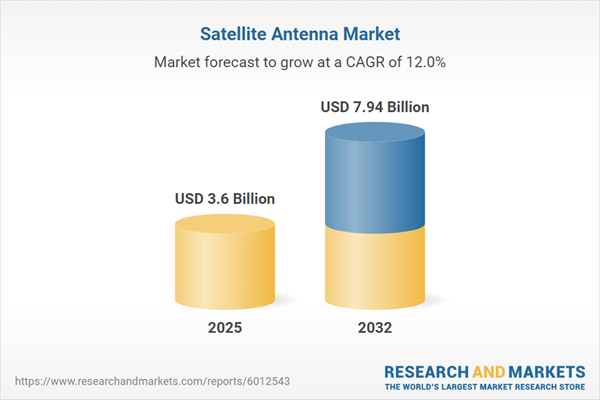Speak directly to the analyst to clarify any post sales queries you may have.
As organizations navigate rapid digital acceleration and evolving connectivity demands, the satellite antenna market is undergoing significant transformation. For senior decision-makers, strategic adaptation and robust communication infrastructure are proving vital to address both operational continuity and new technology integration requirements.
Market Snapshot: Satellite Antenna Market Overview and Growth Drivers
The satellite antenna market is forecast to grow from USD 3.21 billion in 2024 to USD 3.60 billion by 2025, representing a compound annual growth rate (CAGR) of 11.98%. By 2032, overall market value is projected to reach USD 7.94 billion.
Accelerating digital transformation in diverse industries remains a central growth driver as enterprise and public sector organizations require modern satellite antenna systems to maintain nonstop connectivity and reliable operations. Adoption of new antenna technologies is growing across defense, telecommunications, energy, and public service sectors. Strategic focus on scalable, resilient satellite communications and rapid advanced antenna deployment is now essential for business continuity and maintaining a competitive edge within the evolving communication landscape.
Scope & Segmentation Analysis of the Satellite Antenna Market
- Antenna Types: MIMO and phased array antenna solutions support high bandwidth requirements and stable signals, enabling advanced communications in complex and high-demand scenarios.
- Mobility Types: Fixed antennas sustain robust network performance for established facilities, while portable antenna options support quick deployment for temporary or off-grid locations.
- Technology: Active antenna systems automatically adapt to real-time connectivity changes, whereas passive options focus on conserving energy and promoting efficient resource use.
- Platforms: Satellite antennas provide tailored connectivity for land, air, sea, and orbital applications, supporting terrestrial, airborne, maritime, and space-based requirements.
- Frequency Bands: C, Ka, Ku, L, and X bands ensure organizations have avenues for broad data throughput and regional services to match market-specific coverage needs.
- End Users: Commercial, governmental, defense, and energy sectors all rely on purpose-designed satellite antennas for secure, mission-critical communication activities.
- Applications: Primary uses involve broadcasting, high-data-volume transfer, VSAT, earth imaging, observation, defense links, and extending access to mobile and remote internet.
- Geographic Coverage: Major regions include the Americas—namely the United States, Canada, Mexico, and Brazil—alongside Europe, Middle East, Africa, and Asia-Pacific, with regional development guided by varied infrastructure levels and country-specific regulations.
- Covered Companies: Leading technology providers such as Intellian Technologies, Kymeta Corporation, Viasat, Hughes Network Systems, L3Harris Technologies, Comtech Telecommunications, Gilat Satellite Networks, Cobham, KVH Industries, and Norsat International actively shape the market with innovative products and services.
Key Takeaways for Senior Decision-Makers
- Integrating satellite antennas with Internet of Things and autonomous platforms is strengthening operational capacity and advancing seamless borderless communications for critical business use cases.
- Innovations in beamforming and software-defined systems are creating adaptable infrastructure to help enterprises address unique connectivity needs and challenging operational environments.
- Greater collaboration among technology manufacturers, system integrators, and service partners helps accelerate tailored rollout and reduces time-to-market for new satellite communication services.
- Differing regulatory frameworks and infrastructure maturity worldwide increase the demand for customized antenna solutions that help ensure cross-market compliance and efficient operations.
- Modular and cost-effective antenna technologies are encouraging established companies to broaden product lines and update strategies to align with emerging customer preferences and operational models.
- Rising adoption for applications such as earth observation and secure, resilient communications is influencing investment roadmaps for both industry emerging players and leading enterprises.
Tariff Impact Assessment
Recent U.S. tariff adjustments have led to higher costs for core satellite antenna manufacturing components, including chips and RF subsystems. In response, manufacturers are moving towards near-shoring and localizing supply chains, with a greater emphasis on streamlined logistics and robust compliance management. These adaptations help allocate resources to higher-value services, relieving some impacts of supply chain cost volatility and protecting strategic project timelines.
Methodology & Data Sources
This market analysis draws upon executive interviews, technical discussions, policy review, and comprehensive technical literature. Triangulation and scenario-based validation support the findings, ensuring actionable recommendations are aligned with organizational leadership and stakeholder priorities.
Why This Satellite Antenna Market Report Matters
- Delivers actionable insights, aiding leadership in aligning strategies and investments with the latest satellite antenna technology trends and evolving enterprise communication requirements.
- Provides tailored regional market intelligence, supporting competitive positioning and strategic planning as infrastructure and market conditions change globally.
- Enables organizations to take proactive steps in meeting compliance, operational, and supply chain challenges shaped by differing regulatory frameworks and industry standards.
Conclusion
This report equips leaders with clear market intelligence to guide growth planning, enhance organizational resilience, and make confident investment decisions in the evolving satellite antenna sector.
Additional Product Information:
- Purchase of this report includes 1 year online access with quarterly updates.
- This report can be updated on request. Please contact our Customer Experience team using the Ask a Question widget on our website.
Table of Contents
3. Executive Summary
4. Market Overview
7. Cumulative Impact of Artificial Intelligence 2025
Companies Mentioned
The companies profiled in this Satellite Antenna market report include:- Intellian Technologies Co., Ltd.
- Kymeta Corporation
- Viasat, Inc.
- Hughes Network Systems, LLC
- L3Harris Technologies, Inc.
- Comtech Telecommunications Corp.
- Gilat Satellite Networks Ltd.
- Cobham plc
- KVH Industries, Inc.
- Norsat International Inc.
Table Information
| Report Attribute | Details |
|---|---|
| No. of Pages | 188 |
| Published | October 2025 |
| Forecast Period | 2025 - 2032 |
| Estimated Market Value ( USD | $ 3.6 Billion |
| Forecasted Market Value ( USD | $ 7.94 Billion |
| Compound Annual Growth Rate | 11.9% |
| Regions Covered | Global |
| No. of Companies Mentioned | 11 |









